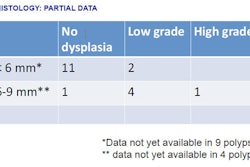CHICAGO - High-pitch dual-source CT (DSCT) scans speed up scanning without harming image quality in most applications, say researchers from the Mayo Clinic in Rochester, MN. DSCT's speedy table times and high temporal resolution could deliver significant advantages in cardiovascular, thoracic, trauma, and pediatric CT, they concluded. Head imaging didn't work as well in high-pitch mode, however.
Results of the first clinical cases using high-pitch scanning combined with DSCT (Definition Flash, Siemens Healthcare, Malvern, PA) for cardiothoracic imaging have been very promising, and suggest that DSCT's heart-stopping temporal resolution of 75 msec has a lot to offer in applications where speed and motion are important. But there has been little quantitative research on the quality of the images produced by high-pitch imaging.
In a study presented at the RSNA meeting, Shuai Leng, Ph.D., and his Mayo Clinic colleagues used a series of phantoms to compare DSCT image quality obtained using pitch values of up to 3.2 compared to single-source CT images obtained at a pitch value of 1.
Using two x-ray sources (64 x 0.6 mm) and two data acquisition systems, spiral pitch values up to 3.2 are achievable with DSCT, Leng said. In contrast to dual-energy imaging applications, high-pitch DSCT scanning mode runs both x-ray tubes at the same energy level.
"Dual-source CT using a 33-cm field-of-view at 0.28 seconds rotation time yields temporal resolution of 0.75 seconds -- at a pitch of 3.2 provides us with a scanning speed of 40 cm per second," Leng explained. "Before clinical application we performed image quality assessments using a series of phantoms with different parameters."
The study compared spatial and low-contrast resolution, image uniformity and noise, and CT value accuracy and linearity using the Reston, VA-based American College of Radiology's (ACR) CT accreditation phantom for single-source scans at pitch 1 and DSCT at pitch 3.2.
The researchers also measured slice sensitivity profiles for a range of slice thicknesses, using an anthropomorphic phantom to assess image artifacts. All results were within ACR parameters, Leng said.
"But when we scanned the head portion, we found artifacts in flash-pitch mode," he said. Head imaging is not included among the manufacturer's recommended high-pitch DSCT applications.
Radiation output (in CTDIvol) was identical for all scans using the same effective mAs (mAs/pitch) for each protocol, he said. Image noise as a function of the spiral pitch was assessed for the dual-source scan mode using a 30-cm diameter cylindrical water phantom scanned at pitch values of 1 to 3.2, in increments of 0.2.
Images of a patient with suspected pulmonary embolism showed substantial motion artifact on a single-source scanner because the patient couldn't sit still, Leng said. DSCT in flash mode stopped the motion entirely.
The study found no differences in quantitative measures of image quality between single-source scans at pitch = 1 and dual-source scans at pitch = 3.2 for every parameter tested, including spatial and low-contrast resolution, CT value accuracy and linearity, slice sensitivity profile, image uniformity, and noise.
The noise values were generally constant between the two modalities, but trended in favor of the low-pitch acquisition, Leng said. However, high-pitch scanning produced more artifacts in structures with rapidly varying attenuation along the z-axis compared to single-source imaging, particularly for head scans.
"The image quality achieved using a single-source pitch 1 scan can be achieved using a recently introduced dual-source high-pitch scan mode within the field-of-view image," he said.
The study was published online November 23 in Medical Physics (December 2009, Vol. 36:12, pp. 5641-5653).
By Eric Barnes
AuntMinnie.com staff writer
November 30, 2009
Related Reading
High-pitch cardiothoracic CTA skips breath-holds and high doses, July 7, 2009
Dual-source CT edges into cardiac SPECT turf, March 6, 2008
CTA predicts functional recovery of the myocardium, September 7, 2007
Dual-source coronary CTA images the calcium-burdened, April 13, 2007
Dual-source imaging promises better CT scanning, June 15, 2007
Copyright © 2009 AuntMinnie.com



















